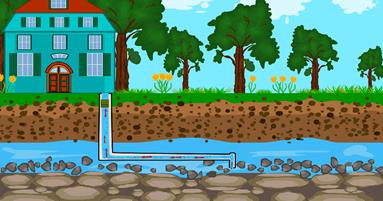Description

Disclaimer: Copyright infringement not intended.
Context
- The Dynamic Ground Water Resources of the country are being periodically assessed jointly by Central Ground Water Board (CGWB) and State Governments. The Data for the same has been released.
Finding of the Data
- Analysis of data of 2020 groundwater assessment with previous assessments suggests an improved groundwater situation in certain parts of the country.
- Ground water level in various parts of the Country is fluctuating because of continuous withdrawal necessitated by increased demand of fresh water for various uses including irrigation, vagaries of rainfall, increased population, food security, industrialization & urbanization etc.
Important initiatives on management of groundwater resources
State wise initiatives
- A number of States have done notable work in the field of water conservation/harvesting such as ‘Mukhyamantri Jal Swavlamban Abhiyan’ in Rajasthan, ‘Jalyukt Shibar’ in Maharashtra, ‘Sujalam Sufalam Abhiyan’ in Gujarat, ‘Mission Kakatiya’ in Telangana, Neeru Chettu’ in Andhra Pradesh, Jal Jeevan Hariyali in Bihar, ‘Jal Hi Jeevan’ in Haryana, and Kudimaramath scheme in Tamil Nadu.
Atal Bhujal Yojana
- Atal Bhujal Yojana (Atal Jal) is being implemented in certain water stressed areas of the country, which includes activities like preparation of water security plan at Gram Panchayat level in participatory mode by involving communities to use available groundwater and surface water in an efficient manner.
Per Drop More Crop
- Department of Agriculture & Farmers Welfare (DA & FW) is implementing Per Drop More Crop component of Pradhan Mantri Krishi Sinchayee Yojana (PMKSY) which is operational from 2015-16. The PMKSY - Per Drop More Crop mainly focuses on water use efficiency at farm level through micro irrigation (drip and sprinkler irrigation system) to reduce the extraction of groundwater.
Jal Shakti Abhiyan
- Government of India launched Jal Shakti Abhiyan (JSA) in 2019, a time-bound campaign with a mission mode approach intended to improve water availability including groundwater conditions in the water-stressed blocks of 256 districts in India.
- Ministry of Jal Shakti has taken up the “Jal Shakti Abhiyan: Catch the Rain” (JSA:CTR) with the theme “Catch the Rain - Where it Falls When it Falls” to cover all the blocks of all districts (rural as well as urban areas) across the country.

‘Master Plan for Artificial Recharge to Groundwater - 2020’
- Central Ground Water Board (CGWB), in consultation with States/UTs, has prepared ‘Master Plan for Artificial Recharge to Groundwater - 2020’. The Master Plan – 2020 is a macro level plan indicating various structures for the different terrain conditions of the country.
- The Master Plan - 2020 envisages construction of about 1.42 crore rain water harvesting and artificial recharge structures in the country to harness 185 Billion Cubic Metre (BCM).
National Aquifer Mapping and Management program (NAQUIM)
- National Aquifer Mapping and Management program (NAQUIM) is being implemented by CGWB as part of Ground Water Management and Regulation (GWM & R) Scheme, a Central Sector scheme. NAQUIM envisages mapping of aquifers (water bearing formations), their characterization and development of Aquifer Management Plans to facilitate sustainable management of groundwater resources in the country. NAQUIM outputs are shared with States/UTs for suitable interventions.
Other
- Government of India generally supports artificial groundwater recharge/water harvesting works in the country through Mahatma Gandhi National Rural Employment Guarantee Scheme (MGNREGS) and Prime Minister Krishi Sinchayee Yojana - Watershed Development component (PMKSY-WDC), ‘Surface Minor Irrigation (SMI) and Repair, Renovation and Restoration (RRR) of Water Bodies schemes’ a component of PMKSY.
Groundwater in India
- Over the last 50 years, the number of borewells has grown from 1 million to 20 million, making India the world’s largest user of groundwater.
- The Central Groundwater Board of India estimates that about 17% of groundwater blocks are overexploited (meaning the rate at which water is extracted exceeds the rate at which the aquifer is able to recharge) while 5% and 14% , respectively, are at critical and semi-critical stages. The situation is particularly alarming in three major regions – north-western, western, and southern peninsular.
- Groundwater pollution and the effects of climate change, including erratic rainfall in the drier areas, put additional stress on groundwater resources.
- The World Bank has been working with the Government of India to enhance groundwater management in affected areas.
Closing Thoughts
- Measures such as surface water harvesting through farm ponds and check-dams, the installation of water-efficient irrigation systems (e.g. more efficient drips and sprinklers) and growing leswater-intensiveve crops, need to be integrated on the demand side for improved management and reduced depletion.
- Several states affected by the depletion of groundwater, provide free or heavily subsidized power (including solar pumps) for pumping groundwater for irrigated agriculture.
- In the long-run, sustainable groundwater management will depend on cross-sectoral reforms to address the water-energy-agriculture nexus and providing the right incentives to resource users. This requires better coordination of policy, ,market and regulatory measures as well as repurposing current public support to more climate-smart solutions.
- Without sufficient regulation or replenishment of aquifers, the increased access to and use of groundwater for irrigation could lead to declining water tables and increasing water scarcity, which risks escalating long-term vulnerability.
Read: https://www.iasgyan.in/daily-current-affairs/jal-jeevan-mission-49
https://pib.gov.in/PressReleaseIframePage.aspx?PRID=1783526












